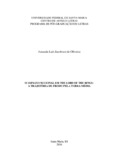| dc.creator | Oliveira, Amanda Laís Jacobsen de | |
| dc.date.accessioned | 2018-01-26T12:42:02Z | |
| dc.date.available | 2018-01-26T12:42:02Z | |
| dc.date.issued | 2016-12-14 | |
| dc.identifier.uri | http://repositorio.ufsm.br/handle/1/12310 | |
| dc.description.abstract | This work arose primarily from two circumstances: my appreciation for J. R. R. Tolkien and his work, and my propensity towards those literary words that evoke images to be not only seen, but also felt. The more I read Tolkien, the more this appreciation grows. My overall goal in this research is to track the spatial elements presented in The Lord of the Rings (1954), centering on the imagetic formations that make abstract ideas into concrete images. Such images enable the reader to visualize those abstractions and connect them to the protagonist of the narrative, Frodo Baggins. Frodo got involved in the Great War of the Ring without meaning to. Nevertheless, he is the only one who can take the Ring back to place where it was forged, in order to destroy it. In spite of considering himself fragile when contrasted with the great enemy, the little hobbit opens his way towards the dark land. The crossing from the Shire (where the hobbits live) to Mordor (the Dark Lord’s land) is long, full of surprises, has unknown places and unexpected meetings. In this sense, the fact that Frodo undertakes a journey is really significant, because it makes him an active character in space and time within the plot. This way, while he wanders through many symptomatic different places (allowing us to keep up with him in this travelling), Frodo provides many pertinent associations between landscape and character, and this plays essential rode in highlighting the antithetical meanings contained in the plot. By connecting the fictional and theoretical readings, I analyse Tolkien’s narrative structure, along with the constitution of space in Middle-earth, to understand the use of the lexicon space and identify how the work’s imagery is composed. In the end of this journey (which becomes our journey, as we keep up with Frodo), I aim to establish in what ways the walkway and the meeting with different places may change the protagonist. | eng |
| dc.language | por | por |
| dc.publisher | Universidade Federal de Santa Maria | por |
| dc.rights | Attribution-NonCommercial-NoDerivatives 4.0 International | * |
| dc.rights.uri | http://creativecommons.org/licenses/by-nc-nd/4.0/ | * |
| dc.subject | Tolkien | por |
| dc.subject | Espaço | por |
| dc.subject | Jornada | por |
| dc.subject | Frodo | por |
| dc.subject | Imagem | por |
| dc.subject | Space | eng |
| dc.subject | Journey | eng |
| dc.subject | Image | eng |
| dc.title | O espaço ficcional em the lord of the rings: a trajetória de frodo pela terra-média | por |
| dc.title.alternative | Fictional space in the lord of the rings: frodo’s path through middle-earth | eng |
| dc.type | Dissertação | por |
| dc.description.resumo | Este trabalho surgiu, principalmente, de duas circunstâncias: minha apreciação por J. R. R. Tolkien e toda a sua obra; e o meu gosto por aquelas palavras literárias que evocam imagens possíveis de serem não só vistas, mas também sentidas. A partir de então, ele cresceu conforme foi sendo desenvolvido. O objetivo geral aqui é estabelecer a pesquisa que rastreia diversos elementos do espaço romanesco em The Lord of the Rings (1954). Através deste estudo, pode-se encontrar muitas constituições imagéticas que tornam ideias abstratas em imagens concretas, possibilitando a sua visualização por parte do leitor. Ademais, interessa o modo como esse espaço se relaciona com o protagonista da narrativa: Frodo Baggins. Frodo foi envolvido na Grande Guerra do Anel sem intenções de o fazer. Entretanto, é ele o único que pode levar o Anel até o local onde foi forjado, a fim de destruí-lo. Apesar de pensar a si mesmo como frágil diante do grande inimigo, o pequeno hobbit inicia seu caminho, em direção à terra sombria. A travessia do Shire (local onde moram os hobbits) até Mordor (a terra do Senhor do Escuro) é longa, repleta de surpresas, lugares desconhecidos e encontros inesperados. Nesse sentido, o fato de Frodo empreender uma jornada é bastante significativo, pois essa condição faz dele um personagem ativo dentro do espaço-tempo do enredo. Dessa forma, ao percorrer lugares sintomaticamente diferentes, e permitindo que o acompanhemos nessa travessia, proporciona muitas associações pertinentes entre paisagem e personagem, constituindo papel essencial nos significados antitéticos da obra. Com a convergência entre as leituras fictícias e teóricas, buscou-se analisar a estrutura narrativa de Tolkien, ao constituir o espaço da Terra-média. Para isso, observa-se a maneira como os diversos elementos romanescos são empregados – como o léxico referente ao espaço, por exemplo – com a finalidade de identificar a composição imagética na obra. Ao fim dessa que, ao acompanhar Frodo, se torna também a nossa jornada, procurou-se estabelecer as maneiras como a passagem e a vivência em diferentes espaços altera a personalidade do protagonista. | por |
| dc.contributor.advisor1 | Tavares, Enéias Farias | |
| dc.contributor.advisor1Lattes | http://lattes.cnpq.br/1655076745935830 | por |
| dc.contributor.referee1 | De Martini, Marcus | |
| dc.contributor.referee1Lattes | http://lattes.cnpq.br/6710912583881896 | por |
| dc.contributor.referee2 | Maggio, Sandra Sirandelo | |
| dc.contributor.referee2Lattes | http://lattes.cnpq.br/0866814477504163 | por |
| dc.creator.Lattes | http://lattes.cnpq.br/6189574099652665 | por |
| dc.publisher.country | Brasil | por |
| dc.publisher.department | Letras | por |
| dc.publisher.initials | UFSM | por |
| dc.publisher.program | Programa de Pós-Graduação em Letras | por |
| dc.subject.cnpq | CNPQ::LINGUISTICA, LETRAS E ARTES::LETRAS | por |
| dc.publisher.unidade | Centro de Artes e Letras | por |



